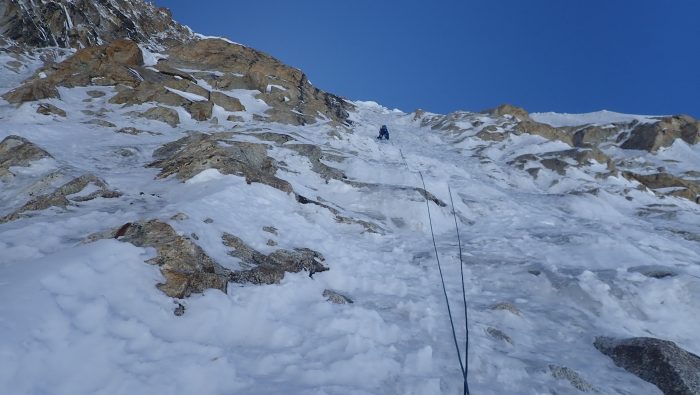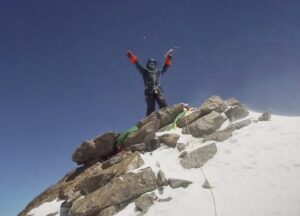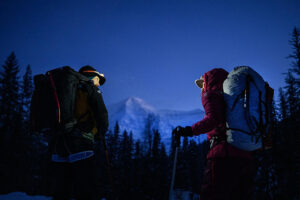With two 8,000m winter firsts on his resumé, Adam Bielecki has strong opinions on the current debate about meteorological vs calendar winter, and other elements of climbing style. He has also confirmed that he is returning to Annapurna’s Northwest Face in spring.

Adam Bielecki near the summit of K2 in July 2012. Photo: Adam Bielecki
The winter debate
Bielecki thinks astronomical (calendar) winter is the best way to define the climbing seasons, for a logical reason: You can apply the same definition all around the world.
“If we used the meteorological winter definition based on the coldest days, we should have to set different dates for every mountain in the world,” he explained. “Better to stick to the simple calendar: four seasons, three months each, based on astronomy.”

The Northwest Face of Annapurna I. Photo: Adam Bielecki
Bielecki believes that dates are secondary to other aspects of style. These can change from one expedition to another, and not all of them are equally important. In high-altitude climbing, for example, the use of oxygen matters much more.
Bielecki has no doubt who pegged the first winter climb of Manaslu: the 1984 Polish team. “They did it in very good style,” he said. “Could their style be improved by another team climbing in the dead of winter? Yes, but if you ask me about Alex Txikon’s expedition, the use of supplementary O2 by most of the team overshadows their better timing.”

Adam Bielecki on the summit of Gasherbrum I in winter. Photo: Adam Bielecki
A natural evolution
At the same time, Bielecki is practical about the current evolution of Himalayan winter climbing, including using helicopters for the approach or acclimatizing in different areas with more comfortable resources.
“It’s part of a natural process,” he said, “just as it was in the Alps. There was a time when the Alps were isolated, without roads, no lifts, and nearly no huts. Climbing there was tough. Now we can just start from the valley, climb a 4,000’er and be back at a restaurant at the end of the day.

Adam Bielecki climbs toward the foot of the Black Pyramid on K2, in the winter of 2018. Photo: Adam Bielecki
“The Himalaya are the same, on a larger scale. The trek can be shortened or avoided altogether by using helicopters. It’s alright. Even alpine-style teams sometimes acclimatize…in a hypoxic chamber.”
For Bielecki, the climb starts and finishes in Base Camp. Catching a helicopter to Camp 2 is “not valid.”

Adam BIelecki on the north face of Gunj-E-Sar. Photo: Adam Bielecki
“What really worries me about style in the Himalaya is the use of oxygen,” he says. “The biggest obstacle to climbing 8,000’ers is the lack of oxygen. When you remove that, it is not the same.”

First ascents of two virgin peaks in the Shimshal Valley. Photo: Adam Bielecki
Bielecki suggests that if you climb without O2 but the people around you are using it, the style falls somewhere between an O2 and a no-O2 climb.
“If there are people with O2 around you, there is always a chance that if things go really wrong, they’ll share their masks,” he says. “Only with no gas available can you prove that you are physically and mentally capable of reaching the summit without oxygen. No lifeline.”

Adam Bielecki on the House Chimney on K2 in 2012. Photo: Adam Bielecki
The K2 revelation
K2 has featured prominently in Adam Bielecki’s evolution as a high-altitude climber. In addition to his winter attempts, he summited K2 in the summer, without supplementary O2, in 2012. Afterward, he made a promise: “Never again will I climb the normal route on an 8,000’er in peak season.”

Denis Urubko and Adam Bielecki enter the Black Pyramid on K2 in 2018. Photo: Adam Bielecki
He explained: “There were 28 other climbers pushing for the top that day. While it seems nothing compared to the current crowds, it was too much for me. We got stuck in a jam during the final push, someone used our tent in Camp 2, ate our food, and left their garbage there. I learned my lesson. This was not a place for me.”
That experience was one of the turning points in his career. The second was when he climbed Tilicho Peak (7,134m) to acclimatize for his alpine-style attempt on Annapurna Northwest Face.

Adam Bielecki during the first ascent of Jarj-E-Dunduk. Photo courtesy of Adam Bielecki
“There, we had to plan everything from scratch,” he recalls. “Find a place to set Base Camp, watch the mountain for three days looking for the right line, decide where we would set the camps, and whether to fix ropes or not. I realized that the 8,000’ers that I have read about in books do not exist anymore. But these lesser peaks provided exactly the kind of adventure I was looking for.

Adam Bielecki at the base of Tilicho Peak. Photo: Adam Bielecki
“I was incredibly happy to be on Gunj-e Sar West (6,150m) and not on a mountain where there were nearly 150 people on the summit at the same time. There is nothing more aesthetic than two climbers and one rope on a mountain.
“Yet I have to admit I am not done with the 8,000’ers, because I also like to be in thin air. So this spring, I will return to Annapurna’s Northwest Face with Felix Berg and Mariusz Hatala.”
Hatala, by the way, also climbed K2 without supplementary O2 last summer.

The route on Gunj-E-Sar of Janusz Golab and Adam Bielecki. Photo: Adam Bielecki






